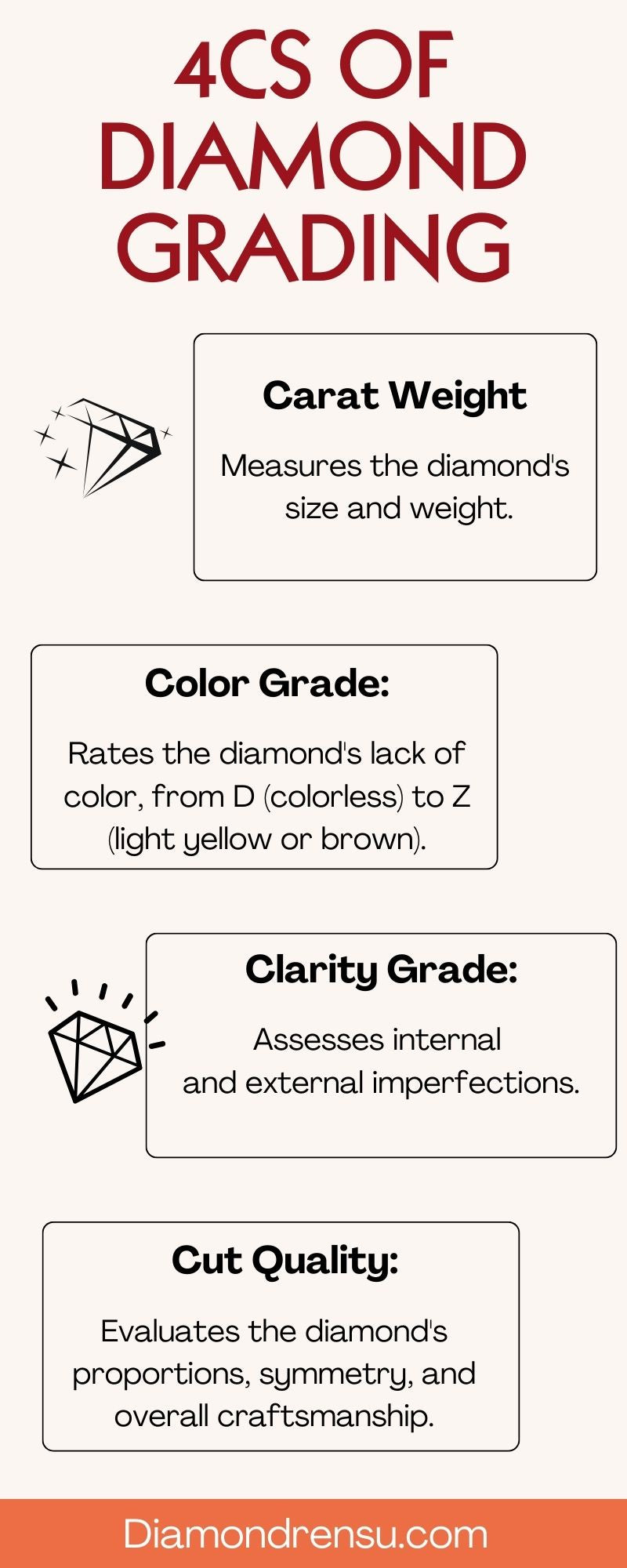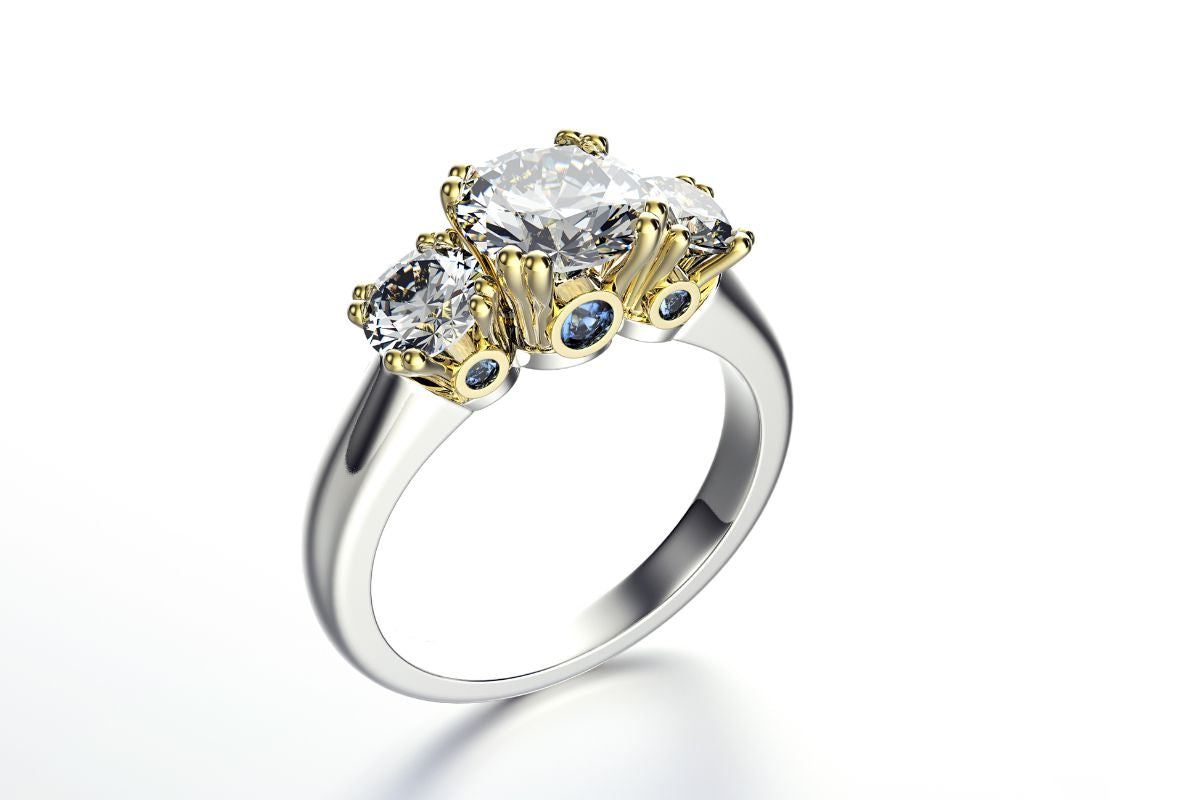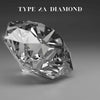
What is an Old Mine Cut Diamond: Unveiling Vintage Gemstone Brilliance
An old mine cut diamond is a type of diamond cut that was prevalent in the late 19th to the early 20th century. Named after the Brazilian and South African diamond mines where they were commonly found, these cuts are recognized for their distinct features. These features include a high crown, a small table, and a large, flat culet. The shape is generally a cushion, with a soft square or even slightly rounded edge, which differentiates it from the more modern round brilliant cut.
My fascination with old mine cut diamonds stems from their hand-crafted nature. Each one possesses a unique character thanks to the individual touch of the cutter. The cutting process emphasized maximizing carat weight over precision, which resulted in deeper stones with an eye-catching glow. They often exhibit a warmth and charm that I find missing in contemporary perfectly-calibrated cuts. With recent years bringing vintage aesthetics back into vogue, old mine cut diamonds have gained a renewed appreciation for their historical significance and romantic allure.
These diamonds are a window into the history of gem cutting, reflecting the technological advancements and cultural preferences of their time. Their softer appearance compared to the sharp brilliance of modern cuts is due to the larger facets, which catch the light in a different, more subtle way. As a result, old mine cuts often display fire, which is the play of colors you see in a diamond, as opposed to just a sparkle. This historical cut continues to enchant me as each old mine diamond tells its own centuries-old story through its unique cut and imperfections.
Historical Context
In my exploration of the old mine cut diamond, it's crucial to understand its historical significance. I'll also explore how this facet style mirrors the evolution of diamond cutting techniques, particularly from the 18th through the 19th centuries.
Origins in India and Brazil
Old mine cut diamonds trace their origins to India, which was the world's initial source of diamonds. By the 18th century, Brazil emerged as another significant player, bringing its own storied gems to the forefront. In these early days, the cutting style was somewhat rudimentary, reflecting the technological constraints of the time. The cut typically featured a squarish shape with a high crown, small table, and a flat or slightly rounded culet, giving it a distinctive, cushioned appearance.
Popularity During Georgian and Victorian Eras
The allure of old mine cut diamonds peaked during the Georgian and Victorian eras. My understanding of their popularity is tied to the romanticism of the Victorian period, as these diamonds became synonymous with the era's intricate jewelry designs. The charm of old mine cut diamonds was inseparable from the narrative of 19th-century elegance, signifying wealth and status during a period of fervent admiration for hand-crafted artistry.
Transition to Old European Cut
As diamond-cutting techniques advanced, old mine cut diamonds gradually gave way to the Old European cut. This progression marked a pivotal evolution in the pursuit of brilliance and symmetry. Skilled gem cutters of the Edwardian era refined the old mine cut, transforming it into the Old European cut. The new cut boasted improved proportions and facets designed to enhance the diamond's sparkle in the burgeoning candlelight-filled ballrooms of the time.
Technical Specifications
| Aspect | Specifications |
|---|---|
| 1. Cut | Old Mine Cut (also known as Old Miner or Antique Cushion Cut) |
| 2. Shape | Generally square or rectangular with rounded corners |
| 3. Facets | Large open facets, typically featuring a small table and a high crown |
| 4. Culet | Small flat facet at the bottom of the diamond |
| 5. Table | Smaller table compared to modern cuts |
| 6. Girdle | Can be thicker compared to modern cuts |
| 7. Facet Arrangement | May exhibit a mix of step-cut and brilliant-cut facets |
| 8. Symmetry | Old Mine Cuts may have irregular shapes and asymmetry compared to modern cuts |
| 9. Era | Popular in the 18th and 19th centuries |
| 10. Characteristics | Known for a unique, romantic appearance with a warm glow and vintage charm |
In this section, I'll detail the characteristics that define the old mine cut diamond and how it compares with other cuts. Understanding these specifics will help appreciate the unique style and craft of this vintage cut.
Defining Features of Old Mine Cut
The old mine cut diamond is a predecessor of the modern cushion cut, known for its deep cut with a high crown, large facets, and a prominent culet. This style typically possesses 58 facets, much like today's standard round brilliant cut diamond, but arranged differently:
- Crown: Remarkably high compared to modern cuts.
- Pavilion: Deeper to increase potential brilliance.
- Culet: Larger than those in current diamond cuts, often visible to the naked eye.
- Table: Smaller in comparison to contemporary diamonds.
- Facets: Broad and chunky, contributing to a distinctive sparkle.
- Symmetry: Often off by modern standards due to being hand-cut.
- Proportion: Generous, contributing to its cushion-like appearance.
This artisan approach to diamond cutting reflects the technological limitations of the time, giving the old mine cut a unique, antique charm.
Comparison with Other Diamond Cuts
When I compare the old mine cut to the modern round brilliant cut, several differences are clear:
- Faceting Style: The modern round brilliant cut features finely calibrated facets designed to optimize light performance. Old mine cuts have less precise facet structures, resulting in a "softer" brilliance.
- Brilliance and Fire: Due to its large facets, the old mine cut displays broader, more dramatic flashes of light, while the modern cut offers a more consistent sparkle.
- Shape: The old mine cut typically has a squarish shape with rounded corners, resembling a cushion, whereas the modern round brilliant cut is circular.
- Precision in Cut: Current diamond cutting employs advanced technology for precise symmetry and proportions, unlike the handcrafted nature of the old mine cut.
- The Evolution: Transitional cuts emerged as diamond cutting technology evolved, gradually leading to the precise cuts seen in modern diamonds.
These distinctions between the old mine cut and newer diamond cuts are a testament to the progression in diamond cutting techniques and standards over time.
Aesthetic Characteristics

Old mine cut diamonds are renowned for their handcrafted individuality and unmistakable historical charm. My focus will be on their unique visual appeal and the notable distinctions in color and clarity that set them apart from modern cuts.
Unique Visual Appeal
When I examine an old mine cut diamond, I'm immediately struck by its distinctive shape and structure. Reminiscent of a cushion cut diamond, this antique style typically displays a square silhouette with rounded corners, lending it a soft, pillow-like appearance.
- Shape: Squarish with rounded corners
- Facets: Large with a high crown and deep pavilion
- Culet: Large culet characteristic of the cut
The large facets of an old mine cut diamond were crafted to optimize the stone's brilliance in the low light conditions prevalent in the era before electric lighting. Thus, in an environment lit by candlelight, these diamonds emit a romantic glow that feels almost alive – a distinctive and desirable trait.
Color and Clarity Distinctions
In terms of color, an old mine cut diamond often possesses a warm color that adds to its alluring presence. While today's color grading aims for colorless stones, old mine cuts in the J-K range of color grades impart a certain warmth that many find pleasing due to its historic connotations.
Color Grades:
- Warm tones
- Often found in the J-K color range
The clarity of an old mine cut is also an area where it markedly differs from modern stones. The hand-cut nature means that each diamond's clarity is as unique as its history. A minor inclusion that might detract from a modern cut can enhance the character of an old mine cut. It's this individuality that draws my attention—it tells a story.
Clarity Distinctions:
- Includes unique inclusions
- Valued for character over perfection
Additionally, the deep pavilion and large culet that I notice within the crystal structure of an old mine cut diamond reflect a bygone era's technological limitations and aesthetic preferences. This combination of traits gives old mine cuts an antique cushion cut's warm, soft look alongside the more brilliant old European diamond cut, creating an eclectic appeal to those seeking something truly unique and steeped in history.
Jewelry and Settings

In my experience with gems, I've found old mine cut diamonds to be quite distinctive, as they often feature prominently in fine jewelry settings, particularly within engagement rings and antique jewelry. These settings enhance the stone's unique beauty and capture their historical allure.
Engagement Rings and Antique Jewelry
For those drawn to the romance of the past, I'd recommend considering an antique engagement ring.
Old mine cut diamonds are particularly beloved for their soft glow and depth, which lend a handcrafted charm to these pieces. When set in engagement rings, they can serve as the centerpiece or be accompanied by smaller stones to complement their vintage character.
Common styles that pair well with these diamonds are:
- Solitaire: A single old mine cut diamond set in a simple band lets the diamond stand out.
- Halo: Smaller diamonds encircle the main stone, adding a dazzling effect and the illusion of greater size.
- Three-stone: Symbolic of the past, present, and future, this setting can combine old mine cuts with other shapes for a unique look.
Antique jewelry, such as earrings and necklaces, can also feature old mine cut diamonds. Since many antique pieces are designed to accentuate the stone's size and shine, they often have larger-than-expected carat weights than modern cuts.
Suitability for Varied Metal Types
Old mine cut diamonds exude warmth and depth, making them versatile across various metal types. Here's how they harmonize with different metals:
- Rose Gold: The diamond's soft luminescence complements the warm pink hues, enhancing the vintage appeal.
- Yellow Gold: Traditional and timeless, yellow gold provides a classic setting that accentuates the diamond's historic charm.
- White Gold: For a more contemporary contrast, white gold can frame an old mine cut diamond, highlighting its brightness.
In my professional opinion, it’s essential to ensure the metal not only matches the old mine cut diamond's aesthetic but also supports its larger facets and particular cut. These factors are integral to the diamond's overall appearance in a setting.
Modern Relevance and Adaptation
The allure of old mine cut diamonds persists in a modern era that values both historic charm and contemporary innovation. These antique diamonds captivate with their romantic provenance and the hand-crafted uniqueness that modern cut diamonds often lack.
Contemporary Demand for Old Mine Cut Diamonds
Consumers today are increasingly drawn to the vintage appeal of old mine cut diamonds. The distinctive soft glow and deep facets of these antique diamond cuts offer a break from the precision of modern cushion cut diamonds.
Boasting a unique shape that maximizes carat weight, these diamonds blend perfectly with both vintage and modern settings, appealing to those who wish to incorporate a sense of history into their jewelry.
Moreover, the GIA certificate associated with old mine cut diamonds authenticates their value and heritage, further enhancing their desirability.
Lab-Grown Alternatives
While original old mine diamonds are finite and cater to a niche market, lab-grown old mine cut diamonds have emerged, providing an ethical and more accessible option.
These diamonds replicate the vintage charm and aesthetic of the antique diamond cut but come with the benefit of modern technology that ensures a conflict-free origin.
Importantly, a lab-grown old mine cut diamond can offer similar visual characteristics to their mined counterparts, which can lead to a lesser environmental impact without compromising on diamond value.
Evaluation and Worth

When assessing an old mine cut diamond, I focus on nuanced specifics that influence both its value and collectability. This vintage diamond cut reflects a hand-crafted appeal, often appraised through a lens that honors its historical context and rarity.
Determining the Value
To accurately determine the value of an old mine cut diamond, I consider the traditional 4 Cs: Carat, Clarity, Color, and Cut quality.
However, due to its antique nature, the craftsmanship and history also play pivotal roles. The cut often presents a distinct, squarish shape with a high crown, larger culet, and deep pavilion, which diverges from modern diamond cuts.
The charm of these features is paramount in its assessment. The old mine cut diamond value is frequently established via professional appraisal, where historical relevance and cut precision significantly influence the final figure.
Investment and Rarity
The investment potential of an old mine cut diamond rests heavily on its rarity and unique character. These diamonds are no longer produced, elevating their status among collectors and investors.
The scarcity of high-quality specimens with desirable 4 Cs attributes boosts their market rarity.
When considering an old mine cut diamond as an investment, I meticulously analyze its historical provenance, condition, and how these factors intertwine to ascertain its allure and monetary worth.
Cultural and Symbolic Significance

Old mine cut diamonds bridge the gap between historical artisanship and the pursuit of brilliance that characterizes my passion for gemology. These cuts not only represent the zenith of craft in their eras but also encapsulate the broader cultural and social narratives of their times.
Representation in Literature and Art
I recognize that old mine cut diamonds have been celebrated in literature and art, embodying the opulence and prestige of their times.
The soft, rounded shapes and the deep cuts of these stones hark back to periods like the Victorian and the Edwardian era, showcasing the grandeur and the intricate aesthetics preferred then.
Artisans from the illustrious Golconda mines were among those who perfected this cut, which often surfaces in the backdrop of period dramas and esteemed paintings, symbolizing wealth and status.
Association with Romance and Luxury
Romance and luxury have long been allied with old mine cut diamonds. The diamond industry today still draws upon the sentimentalism of these cuts; their romantic glow and vintage appeal invoke a nostalgia for eras known for their lavishness and attention to detail.
In my expertise, I've seen how these stones set the tone for what is considered quintessentially luxurious in contemporary and classic settings alike.
The notion of an eternal bond often depicted by the gifting of these luminescent jewels during the Edwardian era continues to resonate deeply within the collective consciousness of society.
Also Read
Frequently Asked Questions
In this section, I'll address common inquiries about old mine cut diamonds, offering concise and accurate information regarding their assessment, distinct features, and value in comparison to modern diamond cuts.
How are old mine cut diamonds appraised for value?
Old mine cut diamonds are appraised based on their carat weight, color, clarity, and how much their cut deviates from their original shape. Unique historical attributes also contribute to their value.
What distinguishes an old mine cut diamond from a modern cut?
The main difference between an old mine cut diamond and modern cuts is the shape and the number of facets. Old mine cuts typically have a squarer shape with a high crown, small table, and a large culet compared to contemporary round brilliant cuts.
What are the identifying characteristics of an old mine cut diamond?
Identifying characteristics of old mine cut diamonds include their cushion-like shape, chunky appearance, and the presence of a culet—the small circular surface at the bottom of the diamond.
When did jewelers transition away from using old mine cuts in diamond rings?
Jewelers largely transitioned away from using old mine cuts during the early 20th century as new cutting techniques were developed and the round brilliant cut became popular.
How does the value of old mine cut diamonds compare to more contemporary cuts?
The value of old mine cut diamonds can be similar to or higher than contemporary cuts, especially if they are in good condition and carry historical significance. The nostalgia and rarity associated with these diamonds often boost their desirability and value.
Are there specific features that influence the price of an old mine cut diamond?
Specific features that influence an old mine cut diamond's price include its historical provenance, overall condition, and how closely it retains its original cut and symmetry.
The charm and uniqueness of each stone can also affect its market price.
Checkout some of our top collections:
Leave a comment
Please note, comments must be approved before they are published.










